Pretty Pistoia is often dubbed `Florence in miniature’ for its vivid cultural life, quiet confidence and its concentration of art and architecture. It is this living culture that sets Pistoia apart from other cities of a similar size. Even so, Pistoia is a much-underrated Tuscan city, despite the boost given by its year in the spotlight as Italy’s Capital of Culture in 2017. The town’s historic heart is delightful and contains one of the loveliest main squares in Tuscany. In un-touristy Pistoia expect to have the Romanesque churches and modern art museums to yourself, even if the popular inns are often overflowing. When dusk falls, the lamp-lit shadowy streets of Pistoia still have an authentic medieval atmosphere. Franciscan monks stride along in their brown habits and rope belts, and the stone slabs outside the shops are laid out with goods for sale, just as they were in the Middle Ages.
This article was crafted by To Tuscany to ensure our guests enjoy the best possible experience during their time in Tuscany. Explore our villas in Pistoia.
Or contact our Villa Specialist team, who are available to assist you. Click here to get in touch.
Pistoia
-
-
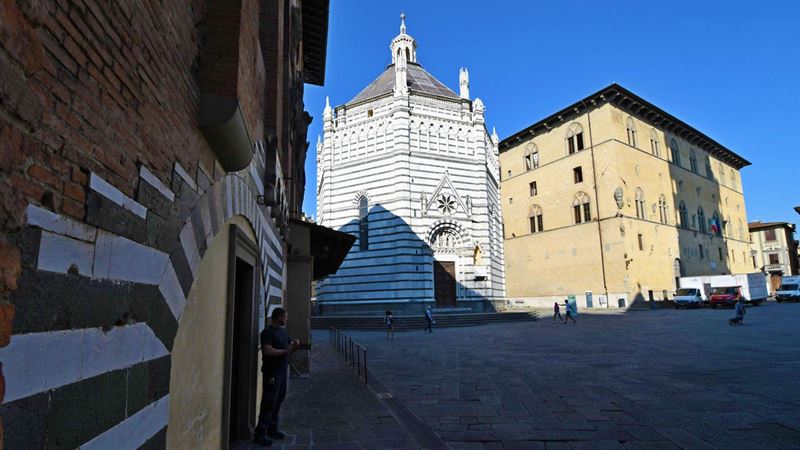
Top Ten Things to do
Pistoia is all about culture, from churches to museums. But the city also likes mixing it up, with medieval art giving way to modern. If suffering from cultural overload, head to a cosy inn or hop on a Vespa. You could also visit Lucca, to the west, or Florence, to the east, on a day trip. If feeling in need of revitalising hot waters, then the elegant spa town of Montecatini makes an easy trip west.
-
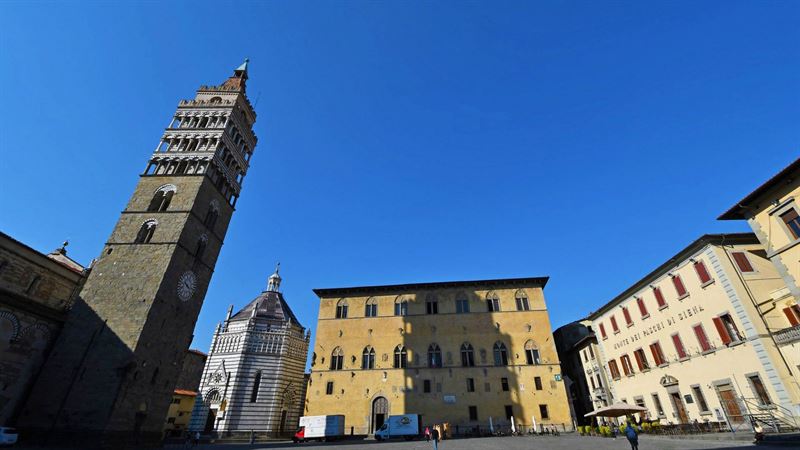
1. Piazza del Duomo – the heart of town
At the heart of Pistoia is the Piazza del Duomo, one of the most beautiful town centres in Tuscany. The star sites are clustered around the main square, making for a dizzying sense of artistic overload. Take it slowly and don’t feel the need to see everything on one visit. Admire the jauntily striped cathedral, the sky-high bell-tower and the wedding-cake baptistery. Welcome to the Cattedrale di San Zeno (Pistoia Cathedral, also known as the Duomo), the Campanile (bell-tower) and the Battistero di San Giovanni (Baptistry of St John). The same square is surveyed by the Palazzo del Comune, the Town Hall, which is home to the Museo Civico (Civic Museum). Nearby stands the Palazzo dei Vescovi, the Bishops’ Palace, which houses the Museo dell’Antico Palazzo dei Vescovi, the Ancient History Museum. The square is framed by a series of handsome Renaissance palaces, including the Palazzo del Podestà, still the city’s law courts, a mansion graced by a finely decorated inner courtyard.
The area around the Piazza del Duomo has been pedestrianised, making it a pleasurable place for pottering. A profusion of bars, inns and elegant shops in this area adds to Pistoia’s appeal. The square itself is lovely, even when full of bustling market stalls on Saturday and Wednesday.
The square also acts as a showcase for city festivities. Pistoia Blues, the renowned international music festival that encompasses far more than the Blues, takes over the square in July. Music legends ranging from BB King, Miles Davis and Sting have played here. More traditionally, the Giostra dell’Orso (Joust of the Bear) takes place here every summer, with the square transformed into a horse-racing track. Much like the Palio in Siena, this medieval tournament captures the hearts of the citizens and involves a chivalric parade and a horse race of sorts. In Pistoia, a series of knights on horseback, representing their city neighbourhoods (rioni), charge at a bear-shaped target against rival knights. As in Siena, the winning neighbourhood is bathed in glory for the whole year. -
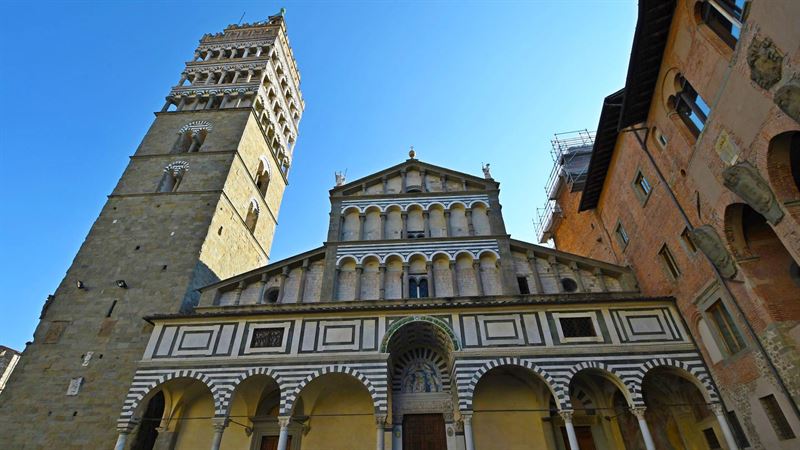
2. La Cattedrale di San Zeno
La Cattedrale di San Zeno, the Pisan-Romanesque cathedral, boasts a splendid 12th-century façade of green-and-white marble stripes. Architecturally, Pisa was the seminal influence in Pistoia as trading links with Spain and North Africa led to a fondness for surface patterning, copying Moorish tilework and textiles. A marble portico was added later and decorated with a delightful blue-and-white Andrea della Robbia bas-relief. Inside are three naves divided by stone pillars and a 14th-century wooden ceiling over the central nave. The interior was remodelled in Renaissance and Baroque times but still reveals a feast of medieval frescoes, some Renaissance paintings and an impressive medieval Crucifix made in 1274. Ignore the macabre `jawbone of St James’, a relic supposedly acquired by San Zeno, for a more appealing tribute to the saint. In the Chapel of St James (Dossale di San Jacopo) prepare to be dazzled by the massive, ornate silver altar. It is decorated with bas-reliefs and statuary added by silversmiths and artists over a period of two centuries, including Brunelleschi. Flanking the Cathedral (Duomo) is the treasury, housed in the Palazzo dei Vescovi. The treasury is so laden with riches that even Dante mentioned it in The Divine Comedy.
Standing sentinel beside the Duomo is the soaring Campanile, built on the site of a Longobard watchtower. This Gothic bell-tower boasts three tiers of green-and-white Pisan arches, reflecting the Duomo façade. The swallow-tail crenellations evoke the Ghibelline period. Climb the bell-tower for a bird’s eye view of Piazza del Duomo, with its array of religious buildings and grand Renaissance palaces. It’s a rewarding climb up 200 steps to views that reveal the city’s wealth of medieval architecture. Opposite the bell-tower is the Battistero di San Giovanni, the 14th-century Baptistery of St John. Designed by Andrea Pisano, this octagonal baptistry is banded in traditional green and white marble. Inside, the solemn mood draws the eye towards the impressive baptismal font, placed in the centre of the octagon, and designed by Lanfranco di Como.
Address: Cathedral of San Zeno
Piazza del Duomo, 51100 Pistoia PT, Italy
Tel: 0573 25095
Web: www.comune.pistoia.it -
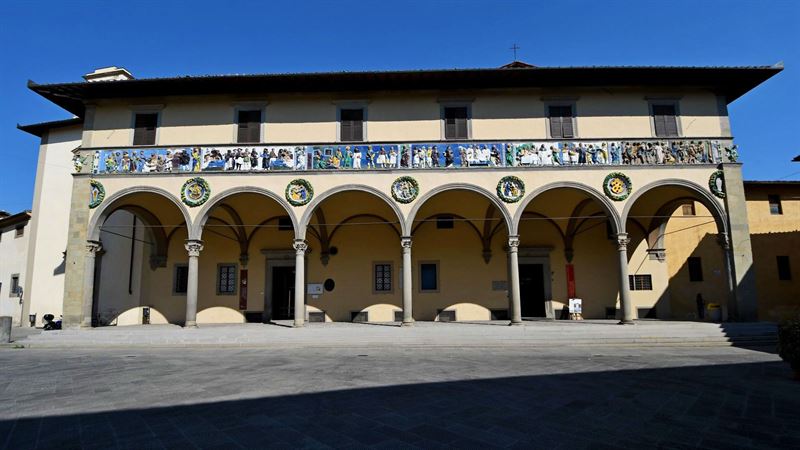
3. Ospedale del Ceppo – mysterious medieval underground tour
North of Piazza del Duomo awaits the 13th-century Ospedale del Ceppo, a monumental medieval hospital. Founded in 1277, this former monastic foundation was on the St James of Compostella pilgrimage route. Rich patrons endowed it, ever since medieval times, and the hospital flourished. So much so that the foundation functioned as a hospital until 2013, when the new Ospedale di San Jacopo opened in the south of the city. Unless you book the fascinating Pistoia Underground tour, you are restricted to admiring the glazed terracotta ceramic frieze that adorns the façade. Decorating the early 16th-century loggia is a vivid polychrome frieze by Giovanni della Robbia. The scenes depict the Seven Works of Mercy (Sette Opere di Misericordia): worthy citizens are handing out food to the poor, comforting prisoners, tending the sick and washing the feet of forlorn travellers. The figures are realistic, and sometimes even humorous, despite their plight.
A curious tour takes you along an intriguing network of underground passages that represent the oldest part of Pistoia, set along the ancient river bed. The tour begins in the courtyard, with the area that once formed the ancient medical school. See old surgical instruments, such as scalpels, including the `Pistoia knife,’ invented here. Discover the `anatomy amphitheatre,’ founded in 1785. This domed dissection hall was where senior medical students would once sit to watch post-mortems. Then it’s time to head underground. Circuitous passageways follow the route carved out by former water channels, first the river and then the canal. En route you come across a 16th-century olive mill which was powered by water and produced olive oil for use in special medical potions and remedies.
The medieval hospital incorporated a river in its structure in the belief that the flowing water would remove all waste and help prevent epidemics. The opposite was, of course, true as epidemics were commonplace, particularly when patients routinely shared beds. To tackle the epidemics, a new canal tunnel was created by diverting the course of the River Brana. You walk along the path of this former canal tunnel, known as the Gora di Scornio. En route you pass a forge where farm tools were made until as recently as 40 years ago. Notice the tiny window workers made use of to check the mill wheel was operating properly. You also pass signs of religious buildings, including a hallway that connected the hospital with a nunnery, the Convento delle Suore Oblate, until the end of the 19th century. The lowest chamber lies under Piazza San Lorenzo, the site of the public wash-houses, and marks the end of the tour. A secret stairway leads upto the square and back to what passes for modern life in Pistoia.
Address: Piazza Papa Giovanni XIII, 14, 51100 Pistoia
Tel: +39 0573 371023
Web: www.irsapt.it -
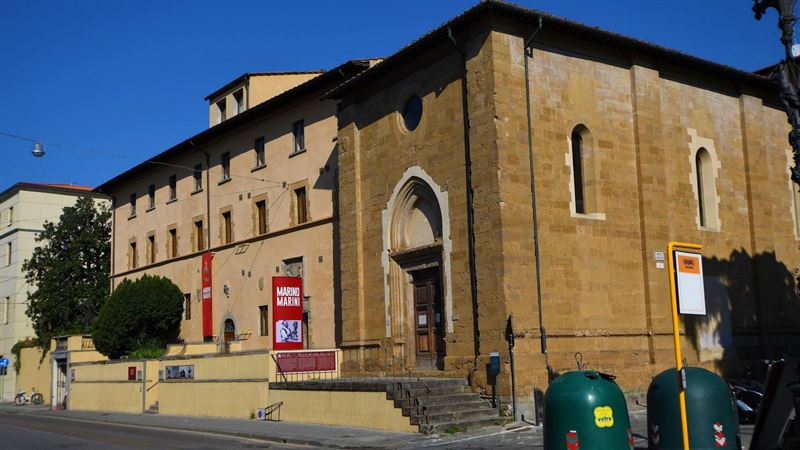
4. Palazzo del Tau – for Gothic frescoes and modern sculpture
South of Piazza del Duomo is the Palazzo del Tau, the main museum of modern sculpture and, in a small chapel, an extraordinary Gothic fresco cycle. The Palazzo del Tau is now home to the Museo Marino Marini, named after Pistoia’s most famous modern son. Sculptor and painter Marino Marini (1901–80) left his home city a major collection of his sculptures, etchings, prints and drawings. All are shown to dazzling effect in this museum. His recurring themes were horses and riders, though he also favoured pear-shaped female nudes, inspired by the Etruscan goddess of fertility. Marini’s work often shows the influence of the Etruscans who settled in Pistoia long before the Romans colonised the town in the 6th century BC. Although less well-known as a portraitist, Marini painted numerous celebrities, including Stravinsky, Marc Chagall, Thomas Mann and Henry Miller. View portraits and sculpture by this prominent sculptor before slipping into the Caffetteria, the museum’s charming café and bakery in the summery, hydrangea-draped courtyard garden next door.
In the adjoining Cappella Tau (Tau Chapel) is a former chapel frescoed with school of Giotto art, and represents the most important Gothic fresco cycle in the city. This tiny chapel features darkly dramatic frescoes on its walls and vaulted ceilings. These 14th-century frescoes, including a fine fresco of The Fall, are inspired by stories from the Old and New Testaments. On all fronts, Pistoia delights in making connections between old and new. As if to prove it, Marini’s monumental equestrian statue on display in the atrium makes a clear connection with modern times. Marini’s works are also visible in the Palazzo Comunale, the Palazzo dei Vescovi and the church of Sant’Andrea.
Address: Palazzo del Tau, Corso Silvano Fedi 30, 51100 Pistoia
Tel: 0573 30285 & 0573 32204
Web: www.fondazionemarinomarini.it -
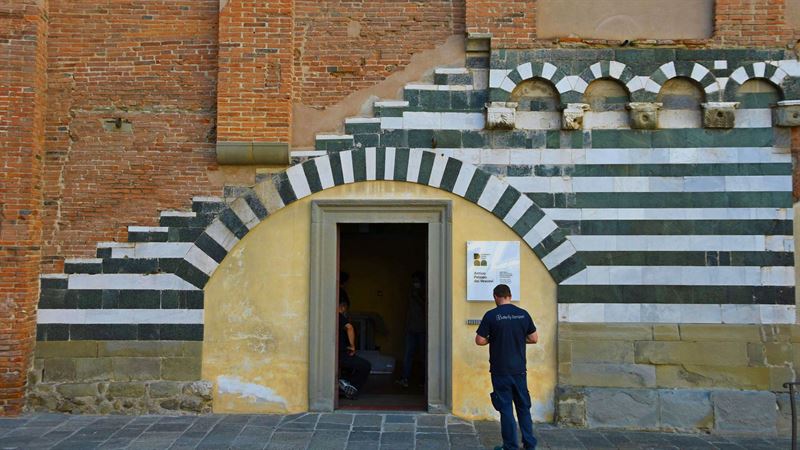
5. Museo dell’Antico Palazzo dei Vescovi – for an historical overview
Wedged next-door to the Cathedral is Palazzo dei Vescovi, the former Bishops’ Palace, with its characteristic lancet arches and mullioned windows. Inside, the Museo dell’Antico Palazzo dei Vescovi brings ancient Pistoia to life. The museum is a stroll through Pistoia’s urban history, ranging from archaeological treasures to touchable models of the medieval Cathedral and Baptistry. Look out for Etruscan funerary slabs and Gothic frescoes. Much has come from the Cathedral Treasury, such as the medieval chalices and reliquaries. The star attraction is the Arazzo Mille Fiori, the Thousand Flowers Tapestry, a late-Gothic tapestry once displayed in the Cathedral. From prancing unicorns to meadows carpeted with flowers, this is a dazzling medieval masterpiece. The 500-year-old tapestry is regularly placed in conjunction with contemporary sculptures or artefacts to create a talking point between ancient and modern.
While exploring the collection, you discover that Pistoia was originally a Roman town and acted as a staging post on the Via Cassia. It was razed to the ground by the invading Lombards in AD 400 but was rebuilt in grander style. Pistoia’s heyday was during the Middle Ages when it flourished as a banking centre and witnessed a building boom. The main square, with its religious and civic masterpieces, dates from this period. After its glory days, Pistoia suffered during the internecine wars between Florence and Lucca and eventually fell under Florentine control. It remained rather a backwater until contemporary times. Only in 2017, with Pistoia’s year as European Capital of Culture, did the city reacquire some of its lost lustre. As is common in Pistoia, this museum is also linked to a cultural centre so is often the setting for exhibitions, talks, classical recitals and jazz sessions.
Address: Piazza del Duomo, 7, 51100 Pistoia PT
Tel: +39 0573 28782
Web: www.comune.pistoia.it -
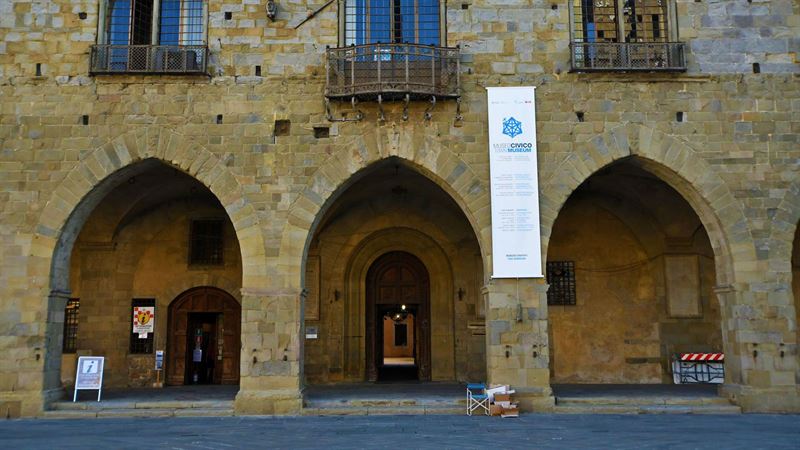
6. Museo Civico - for an artistic display in the Town Hall
It’s hard to escape Pistoia’s main square as it’s the city shop window. Opposite the Palazzo del Podestà is the Palazzo del Comune, the Town Hall where Pistoia’s city council has sat since the 14th century. The Town Hall dates from the beginning of Pistoia's short but proud period as an independent republic. It boasts a harmonious façade of arches and mullioned windows, decorated with the Medici coat of arms and a grim black marble head. Inside is a courtyard and sweeping staircase, and sculptures by local artist Marino Marini, often based on his favourite theme of riders and horses.
Upstairs awaits the wide-ranging city art collection of the Museo Civico, which displays frescoes, paintings and medieval panels rescued from long-closed churches. This Civic Museum is not a star-studded Florentine collection of masterpieces but a modest array of treasures from Pistoia and the Florentine hinterland, showcasing Tuscan art ranging from the 13th to 20th centuries. Even so, in typical city style, the underrated collection over-delivers. The highlights include a rare 13th-century painting of St Francis and charming polychrome wooden sculptures.
If your head is spinning from a surfeit of culture, head to neighbouring Piazza della Sala for a break over coffee or wine. Dubbed "La Sala" by the pistoiesi, this small square is home to wine bars, cafés and restaurants, as well as a daily market. (See Eating & Drinking for our tips).
Address: Piazza del Duomo, 1, 51100 Pistoia PT
Tel: +39 0573 371296
Web: https://musei.comune.pistoia.it/ -
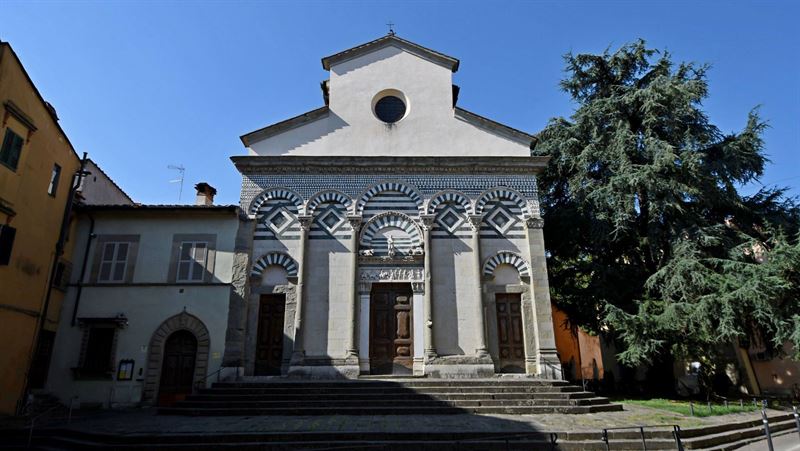
7. A trio of city churches
Pistoia has a rich collection of parish churches, many with notable artworks – in particular the Pisano pulpits, which are the great pride of the town. Elaborately carved baptismal fonts are another highpoint in the city churches. Begin on via Sant’Andrea with Sant’Andrea, the most obviously appealing church. This austerely beautiful place dates back to the days of the Longobards and boasts two masterpieces, a pulpit and crucifix by Pisano. An arcaded façade and sculpted central doorway lead to a lavish painted wooden ceiling and a narrow nave, well-lit from the upper clerestory. Here is one of the famous pulpits by Giovanni Pisano, a dramatic work created between 1298 and 1301. The model was the Nicola Pisano pulpit in the Baptistry in Pisa, sculpted by Giovanni’s father, and considered a turning point in western art. Compared with Giovanni Pisano’s own major pulpit in Pisa Cathedral, this one is even more accomplished. The sharply carved marble reliefs border on the melodramatic in their depiction of The Life of Jesus and The Last Judgement.
Another local favourite is San Bartolomeo in Pantano (St Bartholomew in the Swamp) set on Piazza San Bartolomeo. This 12th-century church is one of Pistoia’s oldest and boasts a five-bay façade studded with marble carvings. Inside is a pulpit by Guido da Como (1250) studded with marble reliefs that depict The Nativity, all supported by sculpted marble lions.
Finally, the pedestrianised via Cavour is home to the Romanesque church of San Giovanni Fuorcivitas, named because it was built outside the city walls. The 12th-century church has an elaborate green-and-white-striped marble façade in true Pisan style. Inside is another impressive pulpit, created in 1270 by Fra Guglielmo da Pisa, a pupil of Nicola Pisano. Equally admirable is the baptismal font by Giovanni Pisano and a touching white-glazed terracotta depiction of The Visitation, by Luca della Robbia.
Address: Sant’Andrea, via Sant’Andrea, Pistoia
San Bartolomeo in Pantano (St Bartholomew in the Swamp), Piazza San Bartolomeo, Pistoia
San Giovanni Fuorcivitas, via Cavour, Pistoia
-
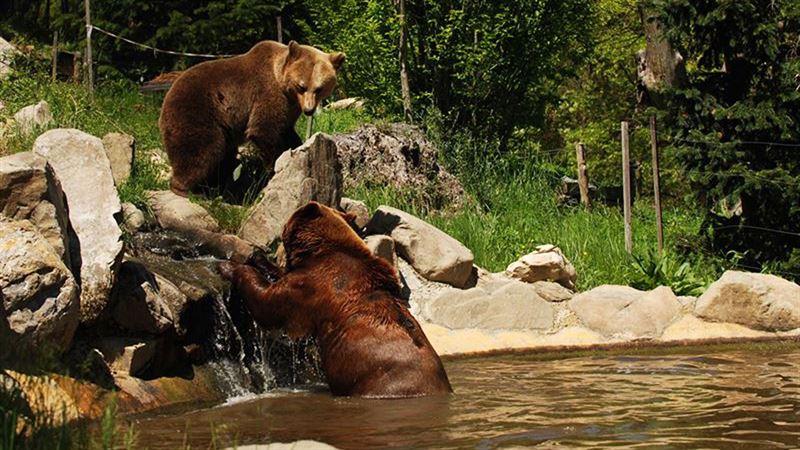
8. From Pistoia Zoo to Pinocchio Park – for the children
If the children are fractious and fed up with sightseeing, then consider a trip to Pistoia Zoo. Known as the Giardino Zoologico di Pistoia, it’s set about 5 km outside town, in a large pine forest. As far as zoos go, this one is pretty small but seemingly well-run, and still makes a welcome change from an overdose on Tuscan culture. This a traditional zoo, displaying everything from penguins to lions, lemurs, hippos and giraffes but what you see will also depend on the weather. At best, the animals can be seen from close to, if, of course, they are in the mood for inspection. On the hottest days some of the animals will hide out, seeking solitude, cover and shade. Activities that may be available range from penguin-feeding to watching the birds of prey fly. The educational side to the zoo includes displays designed to teach children about biodiversity or about the illegal trade in some species, such as exotic parrots. The zoo has recently bought a large strip of land on the western edge of the zoo and is in the process of expansion, in order to give many of the animals the optimal amount of space.
Pinocchio Park is the other family-friendly option in the Pistoia area, and is set in Collodi, a hamlet outside Pescia. It’s here that the writer Carlo Lorenzini invented his classic children’s tale, The Adventures of Pinocchio. This is essentially a sculpture park inspired by the Pinocchio story, and works best for younger children. Complete with a maze, puppet theatre and café, this is not a spectacular theme park but a quietly retro experience. The grounds are dotted with bronzes celebrating the long-nosed puppet, and full of enchanting views. One of the highlights is the Terrible Dogfish Shark, a huge version of the famous whale that eventually swallows up Pinocchio. Your children can climb into the water-splashing sculpture or clamber to the top, from where there is a lovely view of the sculpture park. You can also extend your visit by taking in neighbouring Villa Garzoni and the Butterfly House (see the Pinocchio website for more, including ticket deals). To reach Pinocchio Park by car from Pistoia, take the A11 highway A11 and turn off at the Chiesina Uzzanese exit. Then continue in the direction of Pescia, and before entering the village, follow the signs to Collodi.
Address: Pistoia Zoo, via Pieve a Celle Nuova 160/A, 51100 Pistoia
Web: www.zoodipistoia.it
Tel: 0573 911219
Address: Pinocchio Park (Parco di Pinocchio), via di San Gennaro 5, 51012 Collodi, Pescia
Web: https://www.pinocchio.it/
Tel: 0572 429342
-
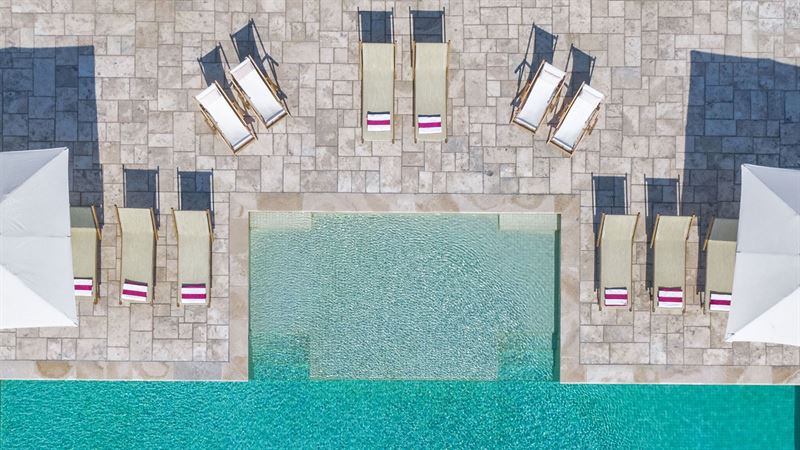
9. Spa country - Monsummano Terme & Montecatini Terme
Pistoia Province is truly diverse, sandwiched between Lucca and Florence, which both make great day trips. Pistoia is bordered by spa country to the south and by mountain country to the north. As the rugged Apennines and the mountain resort of Abetone are a ninety-minute drive from Pistoia, it’s best to focus on sybaritic spa country.
Monsummano Terme, just 18 km south-west of Pistoia, represents a twenty-minute drive to a day’s pampering in thermal waters. Monsummano is the birthplace of the poet Giuseppe Giusti (1809–50) and the site of a particularly wonderful spa, Grotta Giusti Spa Resort, where you can bathe in thermal pools or sweat it out in a bizarre steamy grotto in the grounds of a gorgeous villa. Grotta Giusti manages to combine gracious 19th-century living with superb pampering treatments, thermal pools and sprawling grounds. Book a day spa session, ideally including several treatments, and prepare to be amazed. This upmarket but individualistic spa won `World’s Best Thermal Grotto Spa’ in the latest World Spa Awards, along with `Best Medical Spa’.
The spa’s strange-looking steamy grottoes were dubbed ‘the eighth wonder of the world’ by the operatic Giuseppe Verdi. Spa-goers don bizarre boiler-suits to follow the Dante-esque route into ‘Inferno’, where grottoes named Purgatory, Paradise and Hell induce a surreal detox. After sweating in Hell, there’s floating under the thermal jets in the giant pool, Ayurvedic massage or even a golf session. You might just want to linger over lunch or dinner in this splendid villa, especially as both the bar and restaurant have just been revamped. There’s also a lovely `Saturday evening in the spa’ session.
Neighbouring Montecatini Terme, also south-west of Pistoia, is a twenty-five-minute drive away, and represents the grandest of the old-school Tuscan spa resorts, at least in architectural terms. The whole town is devoted to spa-going. Where Grotta Giusti has moved with the times in some respects, Montecatini remains a dowager resort, somewhat stuck in a time-warp. The resort was rebuilt by Grand Duke Leopold of Tuscany in the 18th century and has since become a company town. Endless avenues of spa buildings dispense health-giving waters to drink and offer treatments ranging from thermal baths and inhalation to the famous mud-baths. You can stroll through the magnificent parks, or sip the waters in marble pavilions – or, of course, you could contemplate a complete cure.
-
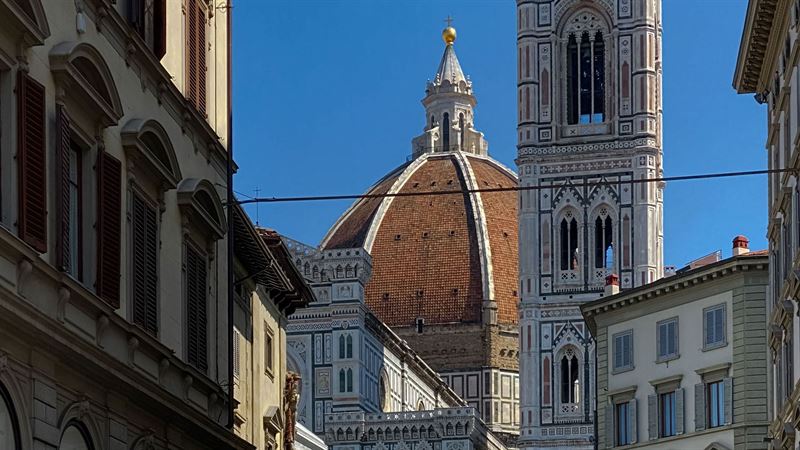
10. Art-filled Florence
Florence lies just 35 km away from Pistoia. Despite devouring the checklist of must-see sights, steer clear of suffocating under the weight of treasures. Allow time for aimless wandering. Beyond the selfie sticks and statuary awaits a funky foodie haunt with sleek cafes, superb cooking and seriously edible markets. Florence is not fusty. Nor has the greedy city lost its gutsy Tuscan soul: traditional inns still serve earthy peasant fare, including macho steaks. Beware of trying to do too much on a day trip. Balance visits to galleries with wanderings in search of the perfect trattoria or the perfect view.
Begin in Piazza della Signoria, the city’s grandest square, with its copy of Michelangelo’s David and, beside it, the crenellated Palazzo Vecchio, with a well-presented collection. After a coffee at Rivoire, brace yourself for the Uffizi Gallery, the world’s greatest collection of Italian art. As such, the gallery is both a feast for the senses and an indigestible banquet so try and plan your visit in advance or even book a time slot online. After lunch, visit the Duomo, the biggest building for miles around. It is still Brunelleschi’s Renaissance dome that defines Florence. Out of respect for Brunelleschi’s achievement, the city forbade the construction of any building taller than the Duomo.
Clear your head in the Oltrarno, across the river Arno, where the Giardino Boboli (Boboli Gardens) act as an excellent antidote to the suffocating splendours of the Pitti Palace. The Medici dynasty created these statuary-encrusted gardens, which became the model for Italianate gardens for centuries to come. Before dinner, explore the Oltrarno neighbourhood's craft heritage on the so-called Left Bank of the city. This bohemian district is studded with stylish bars and buzzy inns interspersed with antique shops, jewellery-makers, picture-restorers and bijou art galleries.
Check our Florence guide to see what appeals most.
If visiting a number of museums, consider buying a Firenze Card online and also book a time slot at the Uffizi Gallery. -
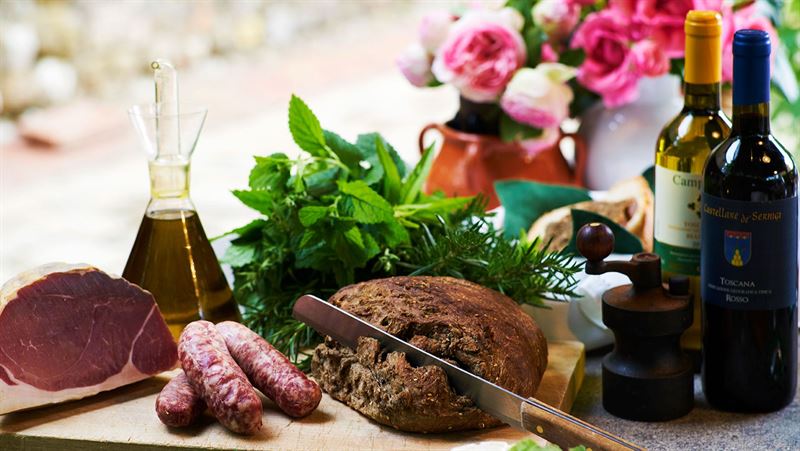
Eating and Drinking
From hot summer nights to cool winter weekends, Pistoia’s pedestrianised squares fill up with local crowds. The pedestrianised area around the main square is full of dining options, especially on via del Lastrone. Street food is also on offer here, including farinata con cavolo, chickpea pancake with cabbage, and frittata con rigatino, omelette with salt-cured bacon. As evening falls, Piazza della Sala, Piazzetta dell’Ortaggio and the surrounding streets turn into the city’s drawing room as the locals meet for aperitivi (cocktails) at cosy wine bars, such as Ristocaffetteria Voronoi (see below).
Pistoia is a foodie hotspot and upholds some of the best Slow Food traditions in Tuscany. The most typical dish is maccheroni sull’anatra, pasta in a rich duck sauce. The wild boar roaming the Tuscan hills found favour with the Etruscan menus, and still feature on local menus. Pistoia is also practised at seasonal vegetable dishes and so-called `cucina povera,’ peasant cuisine. Pappa col pomodoro is one such dish, made with bread and tomatoes, and served colder in summer than in winter.
The city is particularly good at pastries, cakes and chocolate. Chocolates can come in novel flavours, such as nutmeg (noce moscato) or chili pepper (peperoncino). Sugared almonds are popular, as are scole, semi-sweet Lenten Easter cakes. Tasty Castagnaccio is a crunchy chestnut cake made with chestnut flour, walnuts and pine nuts. Pistoia also produces the pretty corona di San Bartolomeo for the feast of St Bartholomew on 24 August, when mothers lead their children to church wearing this cake `necklace’ to receive a blessing from the saint. -
La BotteGaia
Set in Pistoia’s pedestrian zone, close to the Cathedral and Baptistry, this bustling inn is a favourite with the locals. This upmarket yet informal Slow Food inn serves seasonal Tuscan cooking matched by a tempting wine list. The mid-priced dishes range from simple local cheese plates and chicken liver crostini to maltagliati pasta in duck sauce and a range of fish dishes. Dishes are mostly traditional, with occasional creative surprises. If unlucky enough to find a place, head to the inn’s wine bar, La Vineria, on the same street.
Address: Via del Lastrone 17, 51100 Pistoia
Tel: 0573 365602
Web: www.labottegaia.it -
Il Ristocaffetteria Voronoi
Voronoi, a modish yet versatile café and cocktail bar, comes into its own in the early evening when it serves a buffet with cocktails overlooking a pedestrianised square. This mid-priced place also doubles as a pizzeria and a restaurant, serving a surprisingly sophisticated menu. Choose from creative seafood, such as crunchy octopus in batter, asparagus and goat’s cheese risotto, or traditional pasta dishes, such as maccheroni alla pistoese, served in a duck sauce. Instead, for artisanal ice creams, head to the firm’s Gelateria Voronoi, which also sells cakes and pastries (on via Roma 2).
Address: Piazzetta dell'Ortaggio, 14-17, 51100 Pistoia
Tel: 0573 1971214
Web: www.ristocaffetteriavoronoi.it -
L’Enoteca Baldo Vino
This mid-priced wine bar and stylish, creative restaurant is set close to the main square. The cooking is more modish and Italian than solely Tuscan, based on the concept that each wine best matches a precise dish, wherever that dish comes from. A cauliflower flan might be accompanied by baccala from Livorno; octopus with sundried tomatoes could be served with Sicilian capers and anchovies; even the cheeses can range from pecorino to gorgonzola. Fish dishes are to the fore but carnivores are well-served, as, of course, are wine-lovers, with wine-pairing an option on the tasting menu.
Address: Piazza S. Lorenzo, 5, 51100 Pistoia PT, Italy
Tel: +39 0573 21591
Web: https://www.enotecabaldovino.it/ -
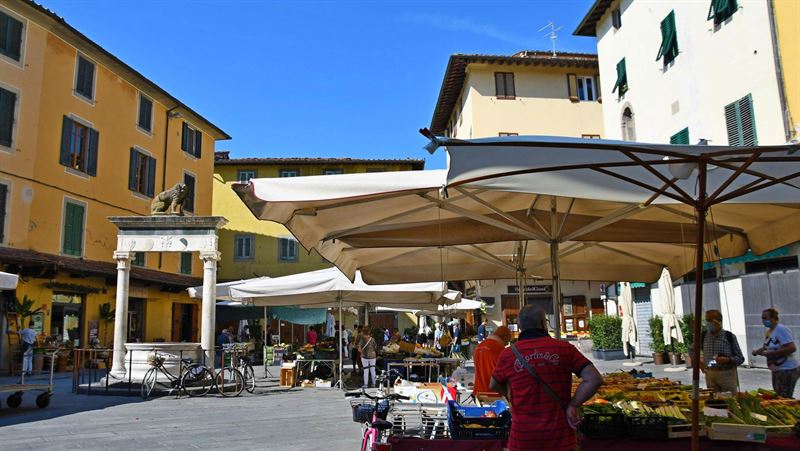
Shopping
In underrated Pistoia you can sometimes find shops as glamorous as those in Florence or Lucca. The main shopping area (embracing via Cavour, via Cino, via Ateo Vannucci and via Orafi) is an inviting place for browsing for clothes, shoes, leather and jewellery.
The main square, the Piazza del Duomo, becomes a bustling market on Saturday and Wednesday. In addition, the daily fruit-and-vegetable market is next-door on car-free Piazza della Sala, set out around an old well. This market has been serving pistoiesi customers since the 11th century, with produce piled high on benches beneath shady canopies. At night the square is home to a number of lively bars. The street names leading off the square illustrate the trades and foodstuffs that sheltered under these canopies. Look out for Fabbri (blacksmiths) and `Caccio’ (cheese) and let your nose lead you to tempting bakeries and pastry shops. -
Bruno Corsini
Founded a century ago, this small but celebrated pastry shop still wows the sweet-toothed locals with traditional biscuits, pastries, chocolate, sugared almonds and cakes, including the Pistoian version of panforte. In particular, come for panforte glacé, also known as panforte pistoiese, a rich chocolate and candied fruit cake which was invented here. On request, you can even watch the cakes being made.
Address: Piazza San Francesco d’Assisi 42, 5100 Pistoia
Tel: 0573 20138 -
Pasticceria Armando
This is a long-established pastry shop which has been serving the sweet-toothed locals since 1948. Come for pastries of every sort, including festive Pistoian Easter treats or Carnival biscuits.
Address: Via Curatone e Montanaa 38, 5100 Pistoia
Tel: 0573 2312 -
Parking & Getting Around
Pistoia provides easier parking options than do many Tuscan towns. In particular, it offers a `park and ride’ service, which lets you park in various car parks on the edge of town and then take the cheap city shuttle. The most convenient (paying) car park for the centre is Parcheggio Misericordia on via Nemoreto, reached from Piazza della Resistenza and via Ducceschi. From the car park, it’s a short stroll to the Centro Storico (historic centre). Also convenient is the (free) Parcheggio Cellini and the (paying) Parcheggio Lingottino.
-
Park and ride (by shuttle bus)
Parcheggio Cellini (free car park) is close enough to walk into the city centre (around 850 metres) and is convenient for Santa Barbara Fortress and the Piazza d’Armi park. If not walking, catch line "M-il Micco" between the car and the town centre, or take the inexpensive shuttle service (navetta).
Parcheggio Stadio is just over 1 km from the centre, with a shuttle bus (navetta) which whisks you into the city. Or take line 1 or "M-il Micco" between the town centre and the car.
Parcheggio Pertini is a good-value paying car park (open 8.30am-8pm) virtually in front of the train station and is most convenient should you be planning to do some rail journeys as well. Otherwise, it is usually pretty full and no closer to the centre than Parcheggio Stadio or Parcheggio Cellini.
Most Tuscan towns operate a strict ZTL system, a Limited Traffic Zone. This means that the Centro Storico (historic centre) is essentially closed to traffic, particularly for non-residents. Cars will need to be left outside the walls. Advice on ZTLs: You may see other cars crossing the ZTL boundary (Limited Traffic Zone) and assume you can proceed. Not so. The drivers crossing into the ZTL zone will probably be locals and have residents’ permits. Visitors do not so are liable to fines. Zones are monitored by cameras, so tickets are issued immediately and automatically, as soon as (and each time) the car crosses the ZTL boundary. -
Getting there
Getting there: Pistoia sits snugly at the foot of the Apennines on the Ombrone Pistoiese, a tributary of the River Arno. From Florence, it’s only a 40-minute drive (35 km); Pistoia is around 42 km from Lucca and 67 km from Pisa.
By car: take the A11 "Firenze-Mare" motorway and leave it at the Pistoia exit, then follow signs for “Pistoia centro”. This leads to the ring road (Raccordo Autostradale) from where you should take the “Viale Europa” exit towards one of the free car parks outside the centro storico, the historic centre.
By train: Pistoia is on the Florence-Lucca-Viareggio line and well-connected. By train, Pistoia is around 45 minutes from Florence; 50 minutes from Pisa Central Station and Pisa Airport Station; 20 minutes from Prato; 45-60 minutes from Lucca; and around 50 minutes from Viareggio. -
Tuscan Villas near Pistoia
In the north of Tuscany lies our collection of villas in the Province of Pistoia, a stone’s throw away from Florence, Lucca and Pisa. With its rich history and picturesque landscapes, Pistoia offers a serene escape when staying close to the city. Our handpicked villas in this region provide a perfect blend of rustic charm and modern amenities, ensuring an authentic Tuscan experience. Get ready to immerse yourself in the beauty of the surrounding olive groves, visit historic sites like the Piazza del Duomo, and indulge in the region's renowned culinary delights. Whether exploring charming villages or relaxing by a pool with panoramic views, our villas near Pistoia promise an unforgettable getaway, combining luxury and the true essence of Tuscany.
Explore our Pistoia and Montecatini villas to start planning your Tuscan holiday today.

























